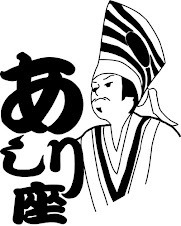What is ningyō-jōruri?
Ningyō-jōruri is a puppet theater, where the performance is a collaborative act between the tayu (narrator), a shamisen player and various puppeteers. The tayū's role is to recite the jōruri, and his performance is accompanied by a shamisen player, whose music evokes the mood and atmosphere of each scene. The play itself is performed by puppets, with three puppeteers usually required to manipulate each doll.
What about jōruri?
Jōruri is a long-standing Japanese oratorical tradition. Its origins can be found at the beginning of the Edo period (1603-1868), when Takemoto Gidayū pioneered a new performance artform by fusing together chracteristics from different types of musical recital traditions, and establishing what was known as the Gidayū-bushi (another name for joruri). It was during Takemoto Gidayū’s lifetime (around 1684) when the basics of the ningyō-jōruri were laid. This is the reason why many tayūs adopt the Takemoto surname; as a mark of respect for the creator of the artform.
What is a shamisen?
A Shamisen is a three-stringed musical instrument, similar to a guitar. It originated in China, and entered Japan through Ryūkyū (now Okinawa), finally reaching Osaka on the mainland around 1560. It took another century to be refined and reconfigurated to its modern form. It is possible to divide shamisens into three categories: the thick, the medium and the thin necked shamisen. In puppet theater, the thick-necked shamisen is used. This type is mostly played, not as an stringed instrument, but rather as a percussion piece, resulting in a very dynamic style. The deep, low sounds from the thick-necked shamisen compliments the tayū’s recital, sometimes leading it to evoke and conjure the appropriate atmosphere.
And the puppets?
From ancient times puppets were used as children’s toys and in religious devotion. Puppetry emerged as an artform during the Heian age (794-1185). Puppets were first used in performances which took place in Shinto shrines and Buddhist temples, where the dramas were usually accompanied by flutes and japanese drums. When Takemoto Gidayū first created the jōruri performance, the puppets were manipulated by only one puppeteer. However, from 1734 on, the three-person team became common. A unique puppetry technique was thereby required and created. Although it is difficult to choreograph the movements of all three puppeteers, the result is an elegant and gracious movement from the puppet itself, a type of movement that you could never observe in real humans.
What kind of stories does ningyō-jōruri tell?
There are two major types of stories told in ningyo joruri. The first is jidaimono, or samurai dramas, which focuses on the famous and ancient (even from the Edo-era viewpoint) stories of nobles and highly-ranked warriors. The second is sewamono. The sewamono is about the daily life of the city-dwellers of Edo (now Tokyo), the problems and conflicts faced by common people in pursuit of love and everyday passions. Among the most famous authors of ningyo joruri we should mention Chikamatsu Monzaemon, the so-called „Japanese Shakespeare”. Monzaemon often adapted real-life events into dramatic performances only a few months after they took place. At one point, performances about love stories that ended in double suicides became so popular as to inspire many real-life copycats. It was such a problem that the government considered banning ningyō-joruri altogether.
Contemporary ningyō-jōruri
After the time of Chikamatsu Monzaemon, who penned more than one hundred plays, there are no major authors to speak of, and only collaborative works were produced. After 1800, the older plays of Monzaemon and others were performed repeatedly, and the puppet theater, on account of its familiarity, gradually became known as a traditional artform. Still, significant advancements did take place. The tayū's oratorical skills were elaborated, the shamisen's melody became more complex, and the movement of the puppets were polished: the result is the Ningyō-joruri as we know it today.

0 件のコメント:
コメントを投稿